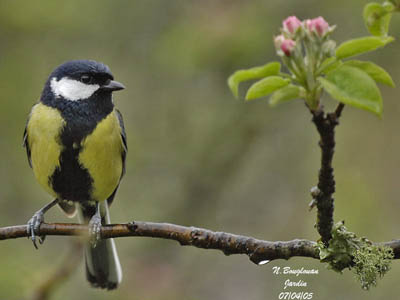
Great Tit
Parus major
Passeriforme Order - Paridae Family
BIOMETRICS:
Length: 13-15 cm ; Wingspan: 23-26 cm ; Weight: 14-22 g
DESCRIPTION:
The Great Tit is a fairly large bird.
Adult male has rather black head with white cheeks and ear-coverts. The nape is glossy bluish-black and shows a whitish central patch at the base.
Mantel is greenish-yellow, turning greener lower, as the upper back and scapulars, the last tinged olive-green. Lower back and uppertail coverts are pale blue-grey, tinged with green on rump.
The tail is blue-grey with blackish inner webs and the outer rectrices are tipped white. The upperwing is greyish-blue and shows a conspicuous white wing bar.
The underparts are yellow (brighter in male). Chin and throat are black, and we can see a black central stripe on breast and belly. This stripe is broader and more conspicuous in male. The undertail coverts are white.
Outside of this black stripe, female is similar to male, slightly duller.
The bill is pointed and black. Eyes are dark brown. Legs and feet are bluish-grey.
Juvenile resembles adults but its plumage is duller, with some brownish areas on head and narrow black stripe in the underparts.

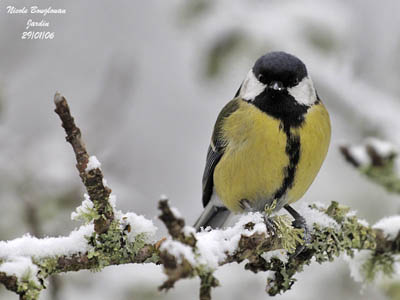
VOICE: SOUNDS BY XENO-CANTO
Great Tit has several calls, and all are loud and ringing, including “chick-pee-chick-pee…”, an alarm call “tink-tink-tink”, also a “zik-zik-doo-doo”, and a harsh scolding “tchairrr” often repeated.
The usual and best known song is a loud and ringing “teechu-teechu-teechu-teechu…”. Some mimicry adds variation to a wide repertoire.
HABITAT:
The Great Tit frequents mixed forests and edges, and clearings in denser woodlands. We find it in orchards, hedgerows, parks and gardens, edges of the cultivated fields, and it lives close to humans in cities and countryside.
RANGE:
Great Tit is widespread throughout Eurasia, from Great Britain to Japan, and also in North Africa.
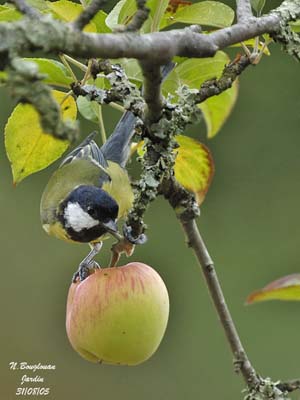
BEHAVIOUR:
The Great Tit feeds as well on the ground as in trees and vegetation. It catches various insects, larvae and spiders. It is also able to extract larvae from pupa in the processionary caterpillars’ nests. It pecks at ripe fruits directly in trees, in order to find the hidden worms inside.
It has fairly strong bill and it is able to break open hard shells of some fruits.
It easily hops on the ground and moves into the trees by grasping firmly at branches. It also may hang in order to reach some insect or any coveted food.
It is a gregarious bird, sometimes seen in small groups outside the breeding season.
It also may be very aggressive, and attacks other nests, to capture chicks. They roost in flocks, in hollows, holes in trees or walls.
Courtship displays are not very elaborated. Male erects its crest feathers, and sticks out its breast, fluffing its feathers, in order to display the wide black stripe and throat.
Great Tit is resident within its habitat, with sometimes some altitudinal movements.
FLIGHT:
Great Tit has an undulating flight. It performs short flights from tree to tree, with rapid wing beats. It may hover to catch insects in midair.
Its flight is undulant, with close wings interspersed with open wings.
REPRODUCTION:
Great Tit nests in hollows in trees, holes, crevices in walls, burrows, holes in rocks, but also in nest-boxes, letter-boxes and pipes.
Female builds the nest adding a lot of materials such as moss, wool, hair and feathers. It is situated from very low level to 6 metres above the ground.
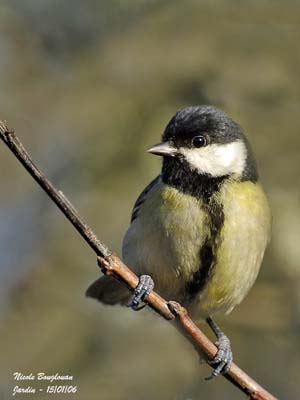
Female lays 6 to 8 white eggs, sparsely spotted with reddish. Incubation lasts about 13 to 16 days by female. Male feeds her at nest.
Altricial chicks are covered with sparse long grey down on head and back. They are fed by both parents, mainly with caterpillars. They grow slowly, opening their eyes only at about 8 to 9 days after hatching.
Young fledge at about 18 to 24 days of age. Both parents feed them for 15 to 25 days more after fledging.
This species produces two broods per season.
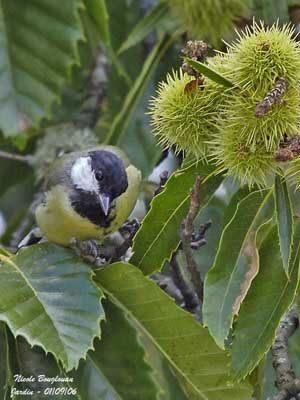
Above: Juveniles before to leave the nest
See also: Reproduction of the Great Tit in the garden
DIET:
Great Tit feeds on invertebrates in spring and summer and also on seeds and fruit in autumn and winter. They frequent bird-feeders in winter.
PROTECTION/THREATS/ STATUS:
Populations of Great Tits have increased since 1960, and they are not threatened at present. They are common and widespread in their range.
These populations are stable, in spite of the high mortality in juveniles, probably due to predation and also to starvation.
Fr : Mésange charbonnière
All : Kohlmeise
Esp : Herrerillo ciáneo
Ital: Cinciallegra
Nd: Koolmees
Russe: Большая синица
Sd: Talgoxe
Photographers:
Françoise Vareille
Nicole Bouglouan
Photographic ramble
Text by Nicole Bouglouan
Sources:
HANDBOOK OF THE BIRDS OF THE WORLD Vol 12 by Josep del Hoyo-Andrew Elliott-David Christie - Lynx Edicions - ISBN: 8496553423
THE HANDBOOK OF BIRD IDENTIFICATION FOR EUROPE AND THE WESTERN PALEARCTIC by Mark Beaman, Steve Madge - C.Helm - ISBN: 0713639601
THE COMPLETE BOOK OF BRITISH BIRDS – Written by “Royal Society for the Protection of Birds” experts - Préface de Magnus Magnusson - Michael Cady- Rob Hume Editors - ISBN: 0749509112
Pájaros de España (JL Beamonte)
Wikipedia (Wikipedia, The Free Encyclopedia)
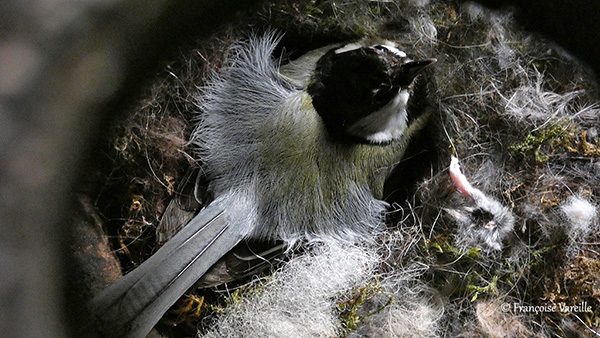
Hatching of the first chick.
It is here with both parents.